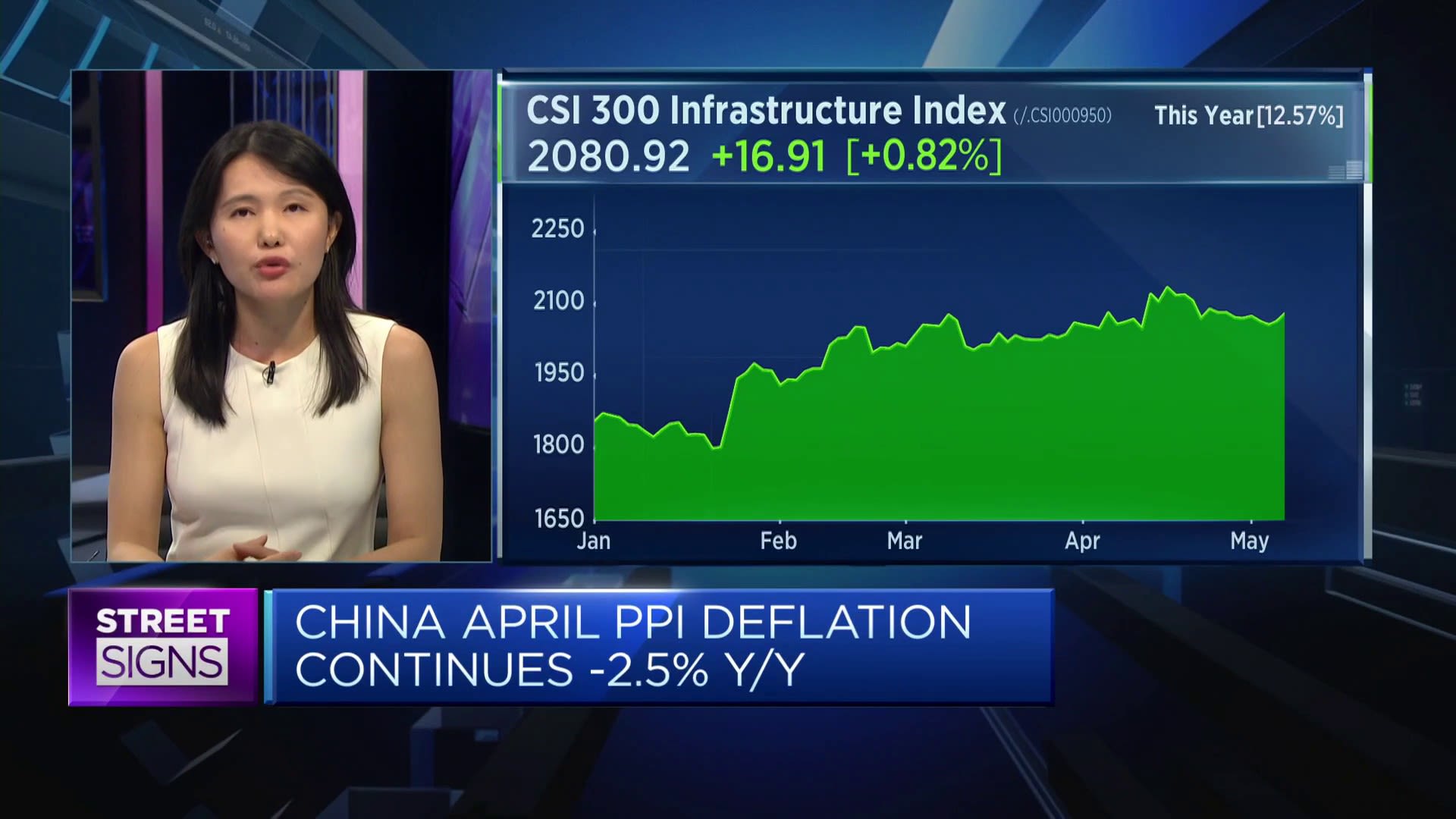People purchasing fruit at an agricultural trade market on May 11, 2024 in Lianyungang, Jiangsu Province of China.
Vcg | Visual China Group | Getty Images
BEIJING — As China’s economy moves into the second quarter of the year, a few indicators are pointing to sluggish growth ahead if things don’t turn around, raising expectations for monetary policy easing.
The National Bureau of Statistics is due to release data on retail sales, industrial production and fixed asset investment for April on Friday. Analysts polled by Reuters as of Tuesday expect a slight increase compared to March.
The same day, China plans to issue its first ultra-long bond — 30 years in term — as Beijing kicks off a previously announced program for a total of 1 trillion yuan ($138.25 billion) in funds for major strategic projects. The Ministry of Finance has not specified what the first tranche will be used for.
Some of the weakness speaks to genuine sluggish demand in China at present.
Hui Shan
Goldman Sachs
“With issuances running all the way until November, it is likely some of the proceeds spending (and therefore benefit to the economy) will only feature in H1 next year,” Louise Loo, lead economist at Oxford Economics, said in a note Tuesday.
The firm expects this week’s economic data releases to show a “softening in economic momentum,” affirming its forecasts for the central bank to cut rates by the end of June.
The central government bond program comes as the drag from real estate persists, while businesses and consumers largely remain conservative about spending.
The People’s Bank of China over the weekend released new loan data for April that pointed to a sharp slump in demand, with several metrics at their lowest in at least two decades.

Goldman Sachs and other firms’ analysts were quick to point out the one-month figures were affected by changes to how official data is calculated, as well as a crackdown on loans used for financial purposes rather than business expansion.
“Some of the weakness speaks to genuine sluggish demand in China at present,” said Hui Shan, Goldman Sachs’ China chief economist, in a note Sunday.
Outstanding loans in Chinese yuan grew by 9.6% year-on-year in April, the same pace as March and the lowest since records began in 1978, according to official data accessed through Wind Information.
Businesses’ loan demand falls
New bank loans to businesses and government organizations dropped sharply in April from March, as did new loans to households, according to official data accessed through Wind Information.
What’s concerning to analysts at Clocktower Group is that the 12-month moving average for both categories of new loans has started to trend downward for the first time since the financial crisis in 2008.
“If the public sector does not come to support credit growth in a timely manner, a sharp growth deceleration is likely to occur going forward as economic agents will be forced to cut consumption and investment to meet their debt obligations,” the firm said in late April.
On a 12-month moving average basis, the new bank loans category including businesses saw a slight increase in April versus March, while new household loans fell during that time, according to CNBC analysis of data accessed through Wind.
The amount of new business loans is still far higher than what it was in 2019, although that of households has fallen below that level, the data showed.
A survey by The China Beige Book in April found that corporate borrowing fell, dragged down by services, while manufacturing saw an increase in demand. The overall decline came despite more loans getting approved and lower interest rates, making it cheaper to borrow.
M2, a measure of money supply that includes cash, cash equivalents and certain deposits, grew by 7.2% in April from a year ago, its slowest pace on record going back to 1986, according to official data accessed through Wind Information.
Less emphasis on credit expansion
“Looking ahead, the growth of new CNY loans and M2 may gradually slow down further, as the PBOC highlighted weakening relationship between economic growth and credit expansion,” Goldman analysts said in a separate report Sunday, referring to the central bank’s quarterly monetary policy report released Friday.
“We continue to expect two more RRR cuts and one policy rate cut through the remainder of this year,” they said.
RRR refers to banks’ reserve requirements, or the amount of cash they need to have on hand. PBOC Governor Pan Gongsheng told reporters in March there was room to further cut that reserve requirement.

“April credit data are disappointing, but that’s mainly due to regulatory changes rather than a sharp deterioration in the underlying demand,” Macquarie’s Chief China Economist Larry Hu said in a report.
“Policymakers don’t want to have another credit-fueled recovery. Instead, they are happy to rely on exports and new energy sectors to drive growth, at least for now,” he said. He expects exports to remain on track for 5% growth this year, while noting the autos sector has done well.
China’s exports have held up despite rising trade tensions. Data released last week showed exports grew year-on-year in April, up by 1.5% and in line with expectations, while imports grew far more than expected.
Separate figures released over the weekend showed a modest pickup in consumer prices in April. But the measure of prices at factories continued to decline.
However, real estate, which once contributed to at least a quarter of China’s economy, remains a drag, despite a growing number of cities easing purchase restrictions.
Real estate sales are increasingly shifting to the secondary market, which means developers don’t benefit much in a market that is still “searching for a bottom,” S&P Global Ratings said in a report early last week.
The S&P analysts expect China’s primary residential market to shrink by 16% this year.
China’s index on home prices is also due out Friday. Looking further ahead, investors are awaiting a major government meeting scheduled for July for signals on longer-term economic policy.
“Separately, the PBOC suggests it will study policies to help digest existing housing inventory and improve new housing supplies in order to stabilize the property market,” Morgan Stanley analysts said.
“We think this echoes the message from the recent Politburo meeting regarding the property market, and shows monetary policy could potentially be used as part of the support measures to help China deal with its significant property inventory.”
— CNBC’s Michael Bloom contributed to this report.
This article was originally published on CNBC

